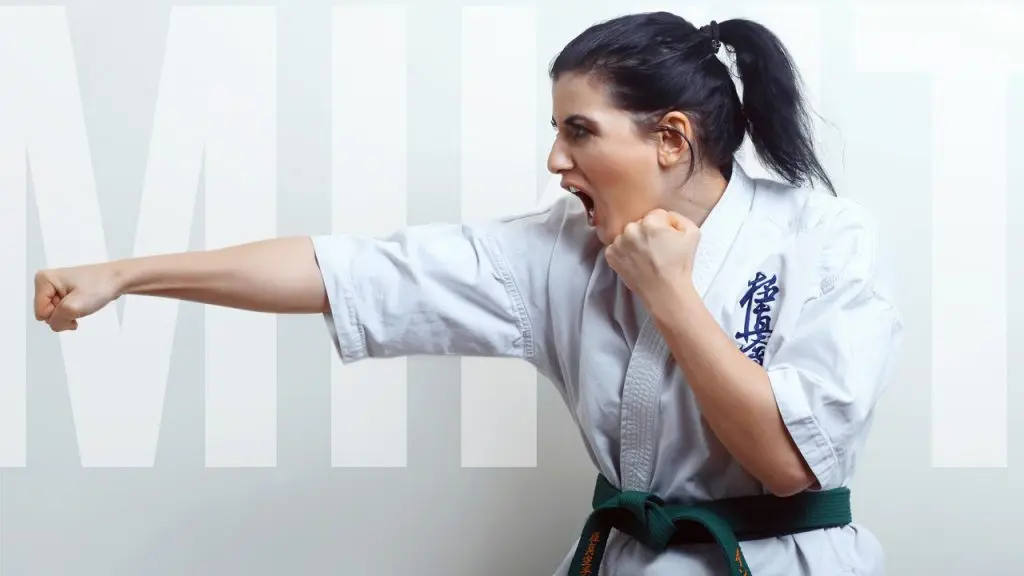Anybody can throw a punch, right? Karate punches are easy. All you have to do is make a fist and smash your opponent in the face. Easy peasy.
That’s what you might think until you actually try to punch someone or something. If you’re lucky, you might simply unbalance yourself and stumble a bit, if you aren’t so lucky you might injure your hand or yourself. At the very least, you’ll learn that throwing a martial arts punch is not as easy as it might seem.
Ready to learn how to do a karate punch and properly knock your opponent’s lights out? Let’s get started.
Table of Contents
Types of Karate Punches
All punches are not created equal. No, we’re not talking about the size or strength of the person throwing it. Instead, we mean the technique. Just as there are various ways you can do a karate kick, there are various karate punches. Here, we’ll talk about choku-zuki, oi-zuki, and gyaku-zuki, the names of punches in Japanese.
Regardless of which type you use, if your technique is correct, the blow can be devastating for your opponent. Karate punches, on the whole, are linear, direct, and incredibly powerful.
Let’s go over how to do them here, starting with the most basic.
1. Basic Standing Punch – Choku-Zuki
Unless you want to end up on your fanny, you’ll need a solid base from which to throw your karate punch or tsuki (punch in Japanese). The power from an off-balance punch will carry you too far in the direction of your punch and send you straight for the floor.
Step 1. Adopt the Correct Stance
Thus, you’ll want to begin from a solid natural stance or horse-riding stance. In a natural stance, your legs should be shoulder-width apart with your knees slightly bent, i.e. not locked into place. For a horse-riding stance, your legs will be farther apart and your body lower, as if you were astride a horse.
For drills, you can remain in your starting position and throw one punch after another to practice your speed and technique.
Step 2. Ready Your Fist
To make a proper fist, hold your hand out straight in front of you as if you were going to shake someone’s hand. Now, curl all the fingers into the palm tightly. Finally, tuck the thumb in on top of your fingers as shown in the photo below. Bring your fist to your hip, palm up, and nest it against your side.
Step 3. Pick Your Target
The two most effective punching targets on the human body are the face and the solar plexus. You’ll want to decide which one you’re aiming for before you send your punch. Hitting most anywhere on the face is effective. Avoid the nose if you would prefer to avoid blood.
The solar plexus is the soft spot just beneath the ribs. A strong punch to this bundle of nerves can leave your opponent disoriented and gasping for air for a few moments.
Step 4. Throw Your Punch
Now it’s time to send your fist out in a straight line at your target, twisting your fist at the end so that your fist is palm down when you strike. Your primary striking surface should be the first two knuckles (index and middle finger knuckles) as this is the strongest part of your hand. Practitioners who have practiced landing karate punches for some time will develop obvious calluses on those two knuckles known as karate knuckles.
Your punch should go out completely straight, with your elbow brushing your side as it extends out. Stay relaxed as you throw the punch until you connect with your target.
Step 5. Blast Your Target
The instant before you make contact with your target, you’ll want to tighten your muscles — all your muscles. Tightening the muscles in your hand and arm are important, but you also need to tighten your core, buttocks, hips, and legs. This will drive power from your entire body into your fist for maximum impact.
Keep in mind that you’ll want to stop just short of hitting your partner in class, but should complete all the movements of the punch, including tightening the muscles. If you’re striking a target, feel free to blast through that bad boy.
Top it off with a strong Kiai for extra oomph.
Check out this great video for a visual explanation.
2. Lunching Punch – Oi-Zuki
The lunching punch is comprised of the same basic punch we just described combined with a forward movement (lunge). The kinetic energy of the step forward adds a tremendous amount of power to the punch.
Step 1. Adopt a Front Stance
Begin in front stance, your feet shoulder-width apart. Instead of in a straight line, one foot (opposite the punching hand) should be just in front of you with the toe turned slightly to the inside and the other just behind. If you are standing correctly and someone pushes your shoulder, you should be able to easily maintain your balance with this base.
Just like for the basic punch, nest your fist palm up at your hip.
Step 2. Move Forward
The movement with the arm is the same, the difference here happens with the feet. As you throw your punch, you’ll take a step forward with the back leg (same side as the punching hand).
Your head should remain level with no up and down movement as you take the step. Additionally, you should arc the leg inward slightly in a curved motion rather than straight forward. Don’t pick the foot up off the floor, but slide it across the floor.
Step 3. Blast Your Target
You should end the technique in the same shoulder-width apart stance as you began, but with the opposite leg. Tense all your muscles the split-second before impact and really drive that power from the heel of your back leg all the way through your body to the tip of your striking knuckles. Exhale sharply or Kiai for maximum force.
Check out this great video for a visual explanation.
3. Reverse Punch – Gyaku-zuki
The reverse again builds off the basic punch, adding a snappy hip twist that will decimate your opponent when done correctly.
Step 1. Adopt a Front Stance
Begin in a front stance, feet shoulder-width apart with one foot in front of you, the other behind. Again, if someone were to push your shoulder, you should be able to easily keep your balance.
Step 2. Add a Hip Twist
The basic punching movement with your arm is the same. The punching fist starts nested at your hip, palm up. You’ll send it straight out, turning the fist over as you punch to land in the same position, striking with the first two knuckles.
However, this time you’re going to add a hip twist just as you would when throwing a ball as hard as you can. This generates power from the strong core of the body and sends it into your opponent through your very bony (and painful!) fist.
Bring your hips around at the same instant as your punch and let the energy flow through your arm to your target, tensing your muscles at the last instant. Kiai or exhale and watch your opponent reel from the impact.
Check out this great video for a visual explanation.
Powerful Punches for the Win!
There are a few more karate hand strikes that you’ll learn as you continue on your karate journey. However, these are the basic karate hand techniques involving a fist. There are a few more advanced techniques that didn’t make our list of karate punches, but that’s more for another time.
Excited to learn more about karate or further perfect your techniques? Check out more of our blogs!


